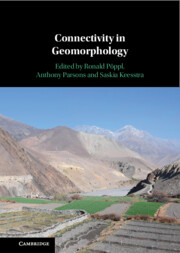Book contents
- Connectivity in Geomorphology
- Connectivity in Geomorphology
- Copyright page
- Contents
- Contributors
- Preface
- Acknowledgements
- Part I Introduction
- Part II Connectivity in Process Domains
- Part III Quantifying Connectivity in Geomorphology
- 9 Measuring Connectivity
- 10 Indices
- 11 Modelling
- Part IV Managing Connectivity
- Index
- References
11 - Modelling
from Part III - Quantifying Connectivity in Geomorphology
Published online by Cambridge University Press: 10 April 2025
- Connectivity in Geomorphology
- Connectivity in Geomorphology
- Copyright page
- Contents
- Contributors
- Preface
- Acknowledgements
- Part I Introduction
- Part II Connectivity in Process Domains
- Part III Quantifying Connectivity in Geomorphology
- 9 Measuring Connectivity
- 10 Indices
- 11 Modelling
- Part IV Managing Connectivity
- Index
- References
Summary
Modelling connectivity is a three-stage process. Foremost, is the conceptualization of the connectivity problem. Two end-members of connectivity may be defined. The first considers connectivity to be an emergent property of a system. The second imposes on the system a specific definition of what connectivity is. The former conceptualisation is useful for applications where feedbacks between functional and structural connectivity occur over a shorter timescale than the duration of the model application, and for developing understanding based on model development and application. The latter is better used where prediction or application of the model results is required. It is further necessary to answer questions about space and time scales of the application and data available to support it. Once the basic units of spatial scale can be defined, development of the model can move on to considering what data are most appropriate at that scale, and how to collect them. In the final stage, different model structures that reflect the emerging and parameterized connectivity end-members are considered. The chapter gives examples of these stages with reference to modelling of water flows and consequent erosion.
Keywords
- Type
- Chapter
- Information
- Connectivity in Geomorphology , pp. 256 - 284Publisher: Cambridge University PressPrint publication year: 2025

